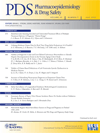Risk of hospitalization for upper gastrointestinal adverse events associated with nonsteroidal anti-inflammatory drugs: a nationwide case-crossover study in Taiwan
ABSTRACT
Purpose
This study aimed to evaluate the risks of upper gastrointestinal (GI) adverse events across a variety of oral and parenteral coxibs and nonselective nonsteroidal anti-inflammatory drugs (nsNSAIDs) in the general population of Taiwan.
Methods
In a case-crossover study, all patients aged ≥20 years who were hospitalized for upper GI adverse events (peptic ulcer and bleeding; gastritis and duodenitis) in 2006 were identified using the International Classification of Diseases, 9th Revision, Clinical Modification diagnosis codes from inpatient claims from the Taiwan National Health Insurance Database. For each patient, the case period was defined as 1–30 days and the control period as 31–60 days before the date of hospitalization. Outpatient pharmacy prescription database was searched for individual NSAID use during the case and control periods. A conditional logistic regression model was applied, and adjusted self-matched odds ratios (OR) and their 95% confidence intervals (95%CI) were reported.
Results
A total of 40 635 patients hospitalized for upper GI adverse events were included. The adjusted OR was 1.52 (95%CI: 1.27–1.82) for celecoxib and 2.56 (95%CI: 2.44–2.69) for oral nsNSAIDs. The ORs were above 2 for oral piroxicam, diclofenac, ketorolac, ketoprofen, acemetacin, and naproxen and were around 1.5 for tiaprofenic acid, indomethacin, mefenamic acid, and ibuprofen. Higher risks were evident for parenteral NSAIDs, in particular ketorolac with an OR of 5.76 (95%CI: 5.14–6.44).
Conclusion
Use of celecoxib and all nsNSAIDs studied was associated with a greater risk of upper GI toxicity as compared with nonuse. Parenteral NSAIDs posed a higher risk, but celecoxib, ibuprofen, and mefenamic acid posed a lower risk than other NSAIDs. Copyright © 2011 John Wiley & Sons, Ltd.




